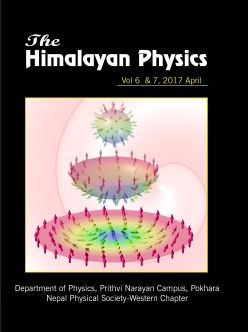Geospatial Analysis of Land Use Land Cover Change Modeling in Phewa Lake Watershed of Nepal by Using GEOMOD Model
DOI:
https://doi.org/10.3126/hj.v6i0.18363Keywords:
GIS, Watershed, Biophysical drivers, Socio-economic drivers, Open Forest, Built-up landAbstract
Improper practices of land use/ land cover (LULC) are deteriorating watershed conditions. Remote sensing and GIS tools were used to study LULC dynamics using GEOMOD Model and predict the future LULC scenario for years 2015 and 2020, in terms of magnitude and direction, based on past trend in Phewa Lake watershed, Kaski district, Nepal. Due to the proximate and underlying causes, land use and land cover change has become the main challenge of the present world The analysis of LULC pattern during 1995, 2000, 2005 and 2010 using satellite-derived maps has shown that the biophysical and socio-economic drivers including slope, road network and settlements proximity have influenced the spatial pattern of the watershed LULC. These lead to an accretive linear growth of Medium to Fairly Dense Forest, Open Forest, Waste Land and Built-up Land but decrease in other LULC classes. Annual rates of increase from 1995 to 2010 in Medium to Fairly Dense Forest, Open Forest, Waste Land and Built-up land were 75.15, 32.7, 10.14 and 24.2 ha/ year respectively, while the rates decrease in Dense Forest, Terrace Agriculture, Valley Agriculture and Bush/Scrub land were 42.58, 58.17, 27.46 and 2.48 ha/year respectively. The predicted LULC scenario for 2015 and 2020, with reasonably good accuracy would provide useful inputs to the LULC planners for effective management of the watershed. The study is a maiden attempt that revealed the expansion of Waste and Built-up Land, which is the main driving force for loss of Agriculture Land and Grass Land, and an increase in Medium to Fairly Dense Forest and Open Forest leading to decrease in Dense Forest and Bush/Scrub Land in the watershed.
The Himalayan Physics Vol. 6 & 7, April 2017 (65-72)
Downloads
Downloads
Published
How to Cite
Issue
Section
License

The articles published in the Himalayan Physics are distributed under a license CC BY-NC-SA 4.0.




